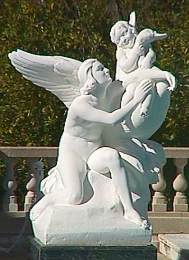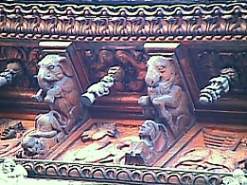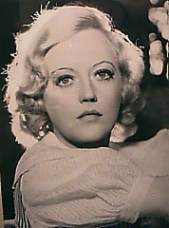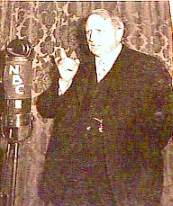
All tours include the
Neptune Pool (a Greco-Roman style outdoor pool) and the Roman
Pool (an indoor pool lined with blue Venetian glass and gold
tiles).
Tour 1 (which is the one suggested to first time visitors)
includes the Casa del Sol (an 18 room guesthouse facing the
Pacific coastline). The Esplanade and Gardens. In the Casa Grande
(main house) you get to see the Assembly Room, the Refectory, the
Morning Room, the Billiard Room, and the Theater.
Tour 2 - includes the Casa Grande's upper floors: the Doge Suite,
"The Cloisters", The Library, the Gothic Suite, and the
Kitchen and Pantry. Tour 3 - includes the North Terrace, the Casa del Monte (a
guesthouse overlooking the Santa  Lucia Mountains), the North Wing of Casa Grande
and a Video illustrating the enormous amount of change and
complexity involved in the construction of Hearst Castle, using
photographs and film from the 1920s and 1930s.
Tour 4 - includes the hidden terrace, Neptune Pool dressing
rooms, an overview of the gardens and grounds, Casa del Mar
(guesthouse overlooking the Pacific Ocean where Hearst resided
during his final years on the estate), and the Wine cellar of
Casa Grande.
After having wandered the visitors center for awhile we opted on
Tour #1. I kind of felt like I was on Price is Right and was
choosing between door #1, #2 or #3. We had learned quite a bit
about William Hearst from the exhibits at the visitors' center
but that was only the tip of the iceberg. Our tour guide
presented a great deal of information while on the tour about
William Hearst. It never ceases to amaze me the ways in which
wealthy people can find to spend their money. We found out
William Randolph's father felt that he was a spendthrift and
would squander any money that was left to him in an inheritance.
So, George Hearst left his entire estate to his wife, Phoebe
Apperson Hearst upon his death in 1891. William Randolph would
not inherit the property until 1919 upon his mother's death. At
that time the "ranch" encompassed 250,000 acres.
Wm. Randolph was born on April 29, 1863 in San Francisco,
California. He
Lucia Mountains), the North Wing of Casa Grande
and a Video illustrating the enormous amount of change and
complexity involved in the construction of Hearst Castle, using
photographs and film from the 1920s and 1930s.
Tour 4 - includes the hidden terrace, Neptune Pool dressing
rooms, an overview of the gardens and grounds, Casa del Mar
(guesthouse overlooking the Pacific Ocean where Hearst resided
during his final years on the estate), and the Wine cellar of
Casa Grande.
After having wandered the visitors center for awhile we opted on
Tour #1. I kind of felt like I was on Price is Right and was
choosing between door #1, #2 or #3. We had learned quite a bit
about William Hearst from the exhibits at the visitors' center
but that was only the tip of the iceberg. Our tour guide
presented a great deal of information while on the tour about
William Hearst. It never ceases to amaze me the ways in which
wealthy people can find to spend their money. We found out
William Randolph's father felt that he was a spendthrift and
would squander any money that was left to him in an inheritance.
So, George Hearst left his entire estate to his wife, Phoebe
Apperson Hearst upon his death in 1891. William Randolph would
not inherit the property until 1919 upon his mother's death. At
that time the "ranch" encompassed 250,000 acres.
Wm. Randolph was born on April 29, 1863 in San Francisco,
California. He was the only child of George and Phoebe. In
1887 his father gave him the San Francisco Examiner newspaper to
run. In 1895 he purchased his second newspaper, the New York
Journal. He was elected to the United States House of
Representative as Congressman from New York in 1902 and
re-elected in 1904. He married Millicent Veronica Willson in
1903. She was 21 and he was 39. They had five sons. After his
mother's death he decided that "the ranch" (as he was
to call it) would be an excellent place for friends and family to
get away from the hustle and bustle of the city. He, at first,
had platform tents built for people to stay in. He then contacted
Julia Morgan, an architect, to build "something that would
be more comfortable" than the platform tents. Julia Morgan
would be involved in the construction on the ranch from 1919
until 1947 when Wm. Randolph would leave San Simeon and all
construction would cease. After a substantial building had been
erected,
was the only child of George and Phoebe. In
1887 his father gave him the San Francisco Examiner newspaper to
run. In 1895 he purchased his second newspaper, the New York
Journal. He was elected to the United States House of
Representative as Congressman from New York in 1902 and
re-elected in 1904. He married Millicent Veronica Willson in
1903. She was 21 and he was 39. They had five sons. After his
mother's death he decided that "the ranch" (as he was
to call it) would be an excellent place for friends and family to
get away from the hustle and bustle of the city. He, at first,
had platform tents built for people to stay in. He then contacted
Julia Morgan, an architect, to build "something that would
be more comfortable" than the platform tents. Julia Morgan
would be involved in the construction on the ranch from 1919
until 1947 when Wm. Randolph would leave San Simeon and all
construction would cease. After a substantial building had been
erected, Wm. Randolph brought his wife and family from
the east coast to live here. Mrs. Randolph found San Simeon too
rustic for her tastes, plus the fact that she missed the social
scene back in New York. Subsequently she took the children and
moved back to their home on the east coast. This left Wm.
Randolph with a huge estate but no hostess. In the meantime, Wm.
Randolph got involved in producing and sometimes directing the
new talking movies. In his association with Hollywood he met a
lady named Marion Davies, who would eventually fill the role of
hostess for San Simeon. It was also said that Marion was Wm.
Randolph's mistress as she lived on the estate most of the time.
I purchased and read a book by Marion Davies called "The
Times We Had." It was a fascinating look into the life and
times of Wm. Randolph. However, if you read this book looking for
a "gold-digging bimbo" to dish the dirt on Wm. Randolph
it just didn't happen. She obviously cared very much about this
man, and protected him when he was alive and after he was dead.
Her book dealt mostly with the people she was able to meet
through her association with Wm. Randolph. It was interesting to
note that when he grew too ill to live at San Simeon any longer
it was to Marion Davis house in Hollywood that he went (in 1947)
and stayed there until his death in 1951.
Wm. Randolph brought his wife and family from
the east coast to live here. Mrs. Randolph found San Simeon too
rustic for her tastes, plus the fact that she missed the social
scene back in New York. Subsequently she took the children and
moved back to their home on the east coast. This left Wm.
Randolph with a huge estate but no hostess. In the meantime, Wm.
Randolph got involved in producing and sometimes directing the
new talking movies. In his association with Hollywood he met a
lady named Marion Davies, who would eventually fill the role of
hostess for San Simeon. It was also said that Marion was Wm.
Randolph's mistress as she lived on the estate most of the time.
I purchased and read a book by Marion Davies called "The
Times We Had." It was a fascinating look into the life and
times of Wm. Randolph. However, if you read this book looking for
a "gold-digging bimbo" to dish the dirt on Wm. Randolph
it just didn't happen. She obviously cared very much about this
man, and protected him when he was alive and after he was dead.
Her book dealt mostly with the people she was able to meet
through her association with Wm. Randolph. It was interesting to
note that when he grew too ill to live at San Simeon any longer
it was to Marion Davis house in Hollywood that he went (in 1947)
and stayed there until his death in 1951.
In addition to running his various newspapers (he owned 18 at the
time of his death), he was an avid aviation enthusiast and flew
in a Bleriot monoplane in 1920 just seven years after the Wright Brothers' first flight. He also produced more
than 100 films. Much of his time was spent collecting antiquities
from all over the world. At the time of his death he had
collected so much that the items were stored in several airplane
hangar-sized buildings. There are still items today that he had
collected that are in storage. He collecting took him to any
number of countries all over the world. Usually when he traveled,
whether by plane or boat, he took Marion Davis with him as well
as an entourage of friends, relatives and just hangars-on who
liked to be seen with the rich and famous.
after the Wright Brothers' first flight. He also produced more
than 100 films. Much of his time was spent collecting antiquities
from all over the world. At the time of his death he had
collected so much that the items were stored in several airplane
hangar-sized buildings. There are still items today that he had
collected that are in storage. He collecting took him to any
number of countries all over the world. Usually when he traveled,
whether by plane or boat, he took Marion Davis with him as well
as an entourage of friends, relatives and just hangars-on who
liked to be seen with the rich and famous.
All I can tell you, is if you get anywhere near that area and
miss the Hearst Castle you have missed a real experience. I only
wish we had had the time to go on more than one tour, but
unfortunately our "move once a week schedule" allows us
to see things once and move on. If we get back this way I think I
would definitely take the evening tour with the docents.
If you would like more
information on the Hearst Castle check out their website at: http://hearstcastle.org or you can call for information and tour ticket
reservations at:
1-800-444-4445.
Good Luck! Have Fun! and Stay Safe!
Laura
